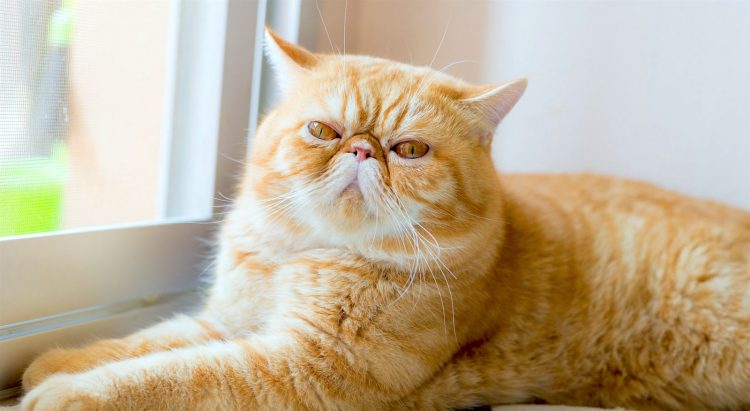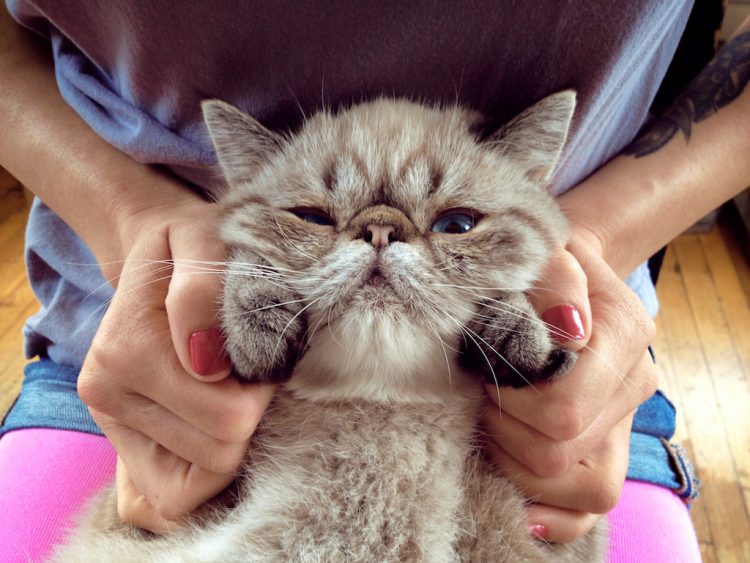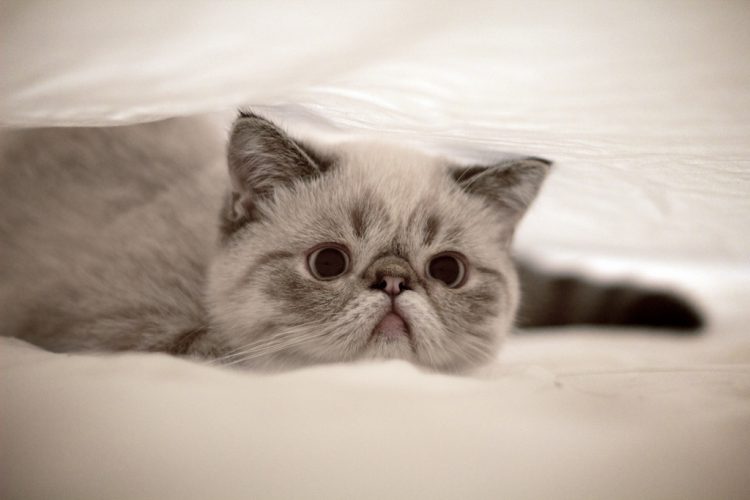
1. Key Characteristics
- Height: 10–12 inches
- Weight: 7–12 pounds
- Life Expectancy: 8–15 years
The Exotic, or Exotic Shorthair, was originally bred as an alternative breed of cat that was like a Persian but with short hair.
Exotics have large, rounded heads with full cheeks and a short, broad nose. The small ears are round-tipped and set both low on the head and wide apart. The eyes come in many different colors.
The cats’ bodies are short and stocky. Exotics’ legs are thick and well-muscled but short. The tail is short but proportionate to body length.
The coat is thick, plush and dense enough that it stands out from the body. While similar to the Persian’s coat, the Exotic’s coat does not get longer than medium length.
The coat comes in many colors, ranging from white to black and everything in between.

2. Where They Came From
According to The International Cat Association (TICA), American Shorthair breeders originally bred to Persians to obtain the silver coloring and green eyes in the 1950s.
The intent was to create an American Shorthair with silver coloring, but breeders discovered that kittens often more closely resembled the Persian.
Breeder Jane Martinke was worried about possible alterations to the American Shorthair bloodline but was also intrigued by this new Persian type of cat. In 1966, Martinke went to the Cat Fanciers’ Association’s (CFA) board of directors and proposed the addition of this breed.
The Exotic was originally named “Sterling” for the silver-colored coats and would have the same standard as the Persian — but without the nose break.
As more Exotics were bred, other Persian coat colors began creeping in and were deemed acceptable by the CFA, but coat characteristics have become a bit tricky. Nancy Robbins, author of Domestic Cats: Their Breeds and Other Facts, says:
“Ironically, longhaired Exotics are not considered Persians by the CFA, although [TICA] accepts them as Persians. Other associations register them as a separate longhair exotic breed.”
The CFA recognized the breed in 1967, and TICA followed suit in 1979.

3. How Friendly Are They?
The CFA describes them as “quiet, sweet, peaceful and loyal companions.”
The Exotic tends to be laid-back and affectionate. They will often be happy to sit in your lap or curl up on your shoulder.
They may enjoy sleeping in your bed, although Exotics do sometimes prefer cooler places to sleep. They also may follow you from room to room. According to the CFA, males are slightly more likely to be affectionate than females.
Exotics are playful and intelligent, enjoying games of all kinds. They are not big “talkers” — when they do meow, their voice is usually soft.
Their easygoing nature makes them a good fit for households with children or other pets.
4. Is This the Right Cat for You?
Exercise Needs
Was YOUR Pet Food Recalled?
Check Now: Blue Buffalo • Science Diet • Purina • Wellness • 4health • Canine Carry Outs • Friskies • Taste of the Wild • See 200+ more brands…

LOW: In the kitten stage, Exotics will be quite playful and energetic.
As they mature, they tend to adopt a more low-key manner. Regular play around the home will satisfy their need for exercise.
Grooming Needs
MEDIUM: Exotics are “the lazy man’s Persian,” thanks to their shorter and easier-to-care-for coats. However, because of their coat density, Exotics should be combed and brushed regularly.
They sometimes suffer from excessive tearing, so you’ll want to wipe their eyes from time to time.
Health Problems
MEDIUM: Exotics face a few diseases or conditions mainly related to their facial conformation and the size of their eyes:
- Breathing difficulties
- Dental malocclusions
- Malformed tear ducts
- Excessive eye tearing
- Entropion, a condition in which the eyelids fold inward
- Dystocia, or difficult or abnormal labor
- Polycystic kidney disease
- Seborrhea oleosa, a skin condition that causes itchiness, redness and hair loss
Watch this patient Exotic get spiffed up by his adoring human:

5. Where to Adopt One
Exotic Shorthairs are popular, so check your nearby shelter or rescue. Often even purebred animals are abandoned, so it’s possible to find a purebred Exotic waiting for a forever home.
Should you decide to go to a breeder, do your research. Reputable breeders probably won’t let you remove a kitten from their mother if they are less than 12 weeks old.
Kittens should also have had their initial vaccinations and be in good health. Have your chosen breeder show you the health histories of both parents — and all cats concerned should be in good health.


